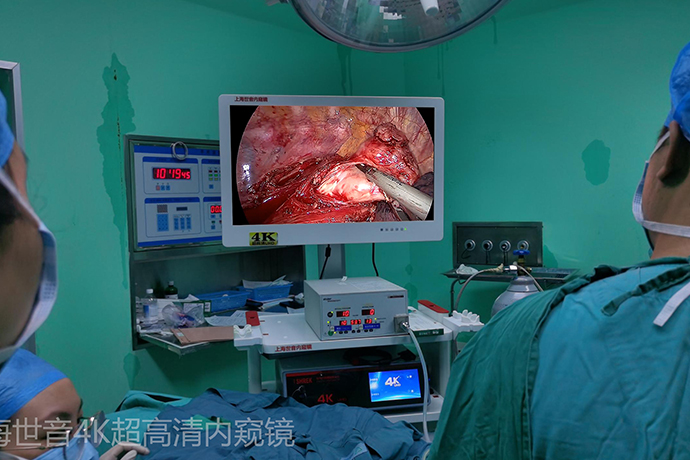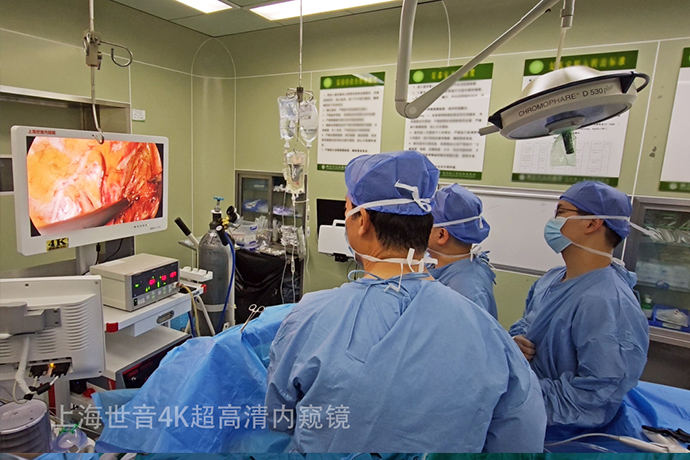[Thoracoscopic Thoracic Surgery] 4K ultra-high definition thoracoscopy for mediastinal tumor resection
Release time: 10 Jan 2024 Author:Shrek
Mediastinum definition
The mediastinum is the organ between the left and right mediastinal pleura. A general term for structural and connective tissue. The mediastinum is sagittal, located in the middle left of the chest, narrow at the top and wide at the bottom, short in front and long in back. The anterior boundary of the mediastinum is the sternum, the posterior boundary is the spine, the mediastinal pleura is on both sides, the upper boundary is the thoracic inlet, and the lower boundary is the diaphragm. Under normal circumstances, the position of the mediastinum is relatively fixed.

The concept of mediastinal tumors
The mediastinum is not an organ, but an anatomical region. The mediastinum contains the heart and the large blood vessels that go in and out of the heart, esophagus, trachea, thymus, nerves and lymphoid tissue. Due to congenital developmental abnormalities and acquired cysts or tumor formation, mediastinal tumors become mediastinal tumors.
Mediastinal divisions
The four-section method is usually used, and the upper and lower mediastinum are divided into the plane of the sternal angle and the lower edge of the fourth thoracic vertebra; the lower mediastinum is divided into the anterior mediastinum, the middle mediastinum and the posterior mediastinum based on the anterior and posterior walls of the pericardium.
1. Anterior mediastinum
Superior mediastinum to diaphragm and sternum to pericardium
2.Posterior mediastinum
All tissues behind the pericardium
3.Middle mediastinum
All tissues from the anterior mediastinum to the posterior mediastinum
Clinical manifestations
1. The manifestations of mediastinal tumors are diverse, ranging from asymptomatic to symptoms related to invasion and compression and systemic symptoms.
2. Symptoms are related to tumor size, location, growth direction and speed, texture, nature, etc.
3. Benign tumors grow slowly and symptoms appear late and mildly.
4. Malignant tumors have a high degree of erosion, rapid progression, and early onset of symptoms.
5. Common symptoms include chest pain, chest tightness, cough, symptoms that stimulate or compress the respiratory system, nervous system, gastrointestinal blood vessels, and esophagus.
6. Specific symptoms related to the nature of the tumor.
Anesthesia method and position
Anesthesia method: general anesthesia, double-lumen endotracheal intubation
Surgical position: Cooperate with the anesthetist and surgeon to place the patient in a 90° lateral decubitus position on the healthy side. Raise the affected upper limb and fix it on the support frame. Place a chest pad under the chest. The upper leg is slightly bent and the lower leg is straightened. A soft pad is placed between the legs, the pelvis is fixed, a headband is placed under the head, and the operating table is turned into a folding knife position to open the intercostal space.
Surgical steps
1. Anterior mediastinal tumor: Make a small incision at the junction of the 5th and 6th intercostal space on the left or right side and the mid-axillary line as the thoracoscopic entrance.
2. Middle mediastinal tumors: Take the junction of the mid-axillary line and the 6th and 7th intercostal spaces as the observation hole, and use the junction of the anterior axillary line and the 4th intercostal space and the junction of the posterior axillary line and the 6th intercostal space as two operating holes.
3. Posterior mediastinal tumors: Use the junction of the 5th and 6th intercostal spaces in the anterior axillary line as the observation hole, and adjust the operating hole appropriately according to the location of the tumor.
Postoperative care
1. Lying position
Those who are not awake after general anesthesia should lie flat on their backs with their heads turned to one side. After you wake up and your blood pressure stabilizes, take a semi-recumbent position, which is beneficial to breathing and chest drainage.
2.Respiratory tract care
Inhale oxygen; instruct the patient to consciously control breathing techniques to promote lung expansion and increase lung ventilation; dilute sputum and follow doctor's advice for treatment.
3. Pain care
Distract the patient's attention; lie in a comfortable position to reduce stimulation; use analgesics as directed by the doctor if necessary.
4. Improve body resistance
Supplement nutrition, eat more light and easy-to-digest foods that are high in protein, high in calories, and rich in vitamins to improve immunity and promote wound healing; encourage getting out of bed early.
5. Catheter care; keep the pipe closed and the drainage smooth. Perform strict aseptic operation, observe and record the color, quantity and nature of the drainage fluid to prevent active bleeding (100-200ml per hour).

- Recommended news
- 【General Surgery Laparoscopy】Cholecystectomy
- Surgery Steps of Hysteroscopy for Intrauterine Adhesion
- [Gynecological Hysteroscopy] Techniques for Preventing and Treating Complications of Hysteroscopic Surgery
- [Gynecological Hysteroscopy] Hysteroscopic Adhesiolysis
- [Gynecological Hysteroscopy] IUD Removal under Hysteroscopy